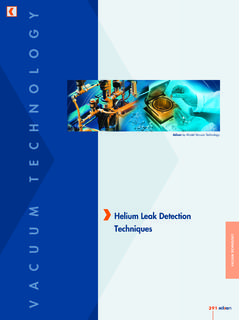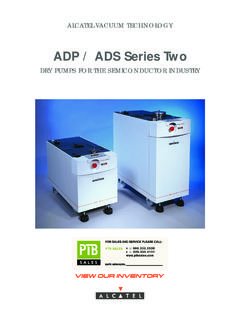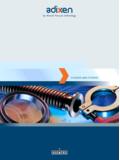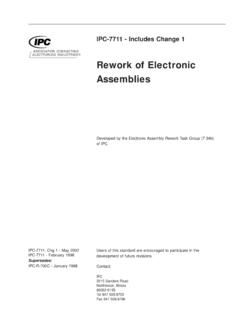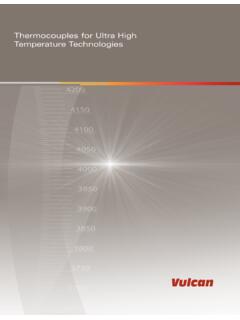Transcription of ASSEMBLY Preventing Corrosion Of PCB Assemblies
1 OnBoard technology October 2008 - page is an inevitable fact in our increasingly polluted environ-ment. Corrosion can be mitigated in several ways. The materials used in the manufacture of electronic devices need to be chosen wisely, based on available Corrosion data. The materials should be protected from pollution by the use of pro-tective coatings, device enclosures, or relocation of equipment to more protected environments. Humidity is a chief contributor to Corrosion , as water allows intimate access of concentrated contaminating spe-cies and transportation of corro-sion products. The choice of pro-tective films needs to be weighed against other functional aspects of the film choices. Materials used in electronics manufacture will in-teract with different pollutants at differing rates based on pollutant levels and other environmental ef-fects.
2 In some cases, galvanic pairs can be created when using dissimi-lar materials, which can accelerate Corrosion . To predict Corrosion , and useful service life of electronic devices, historical data set can be consulted, but gaps exist in the rate of Corrosion on surface finish-ing materials used in today s elec-tronics. To fill in data gaps, indus-try groups can share resources in studying Corrosion . New findings will allow for better predictability on service life, selection of appro-priate coatings to fit specific needs, and development of more robust materials to protect electronics equipment manu-facturing industry encounters many challenges, including: fast time-to-market, diminishing prod-uct cycle, piracy of circuitry layout, and the need for uninterrupted re-liability for as long as 25 years in sectors such as telecom.
3 Reliability is one factor which remains largely in their control, but new market dynamics are challenging the reli-ability factor as well. Corrosion -in-duced service failures are increas-ing at a troubling rate. Corrosion of printed circuit boards can have the effect of causing electrical opens in very fine line circuitry, as well as the creation of electrical shorts when the Corrosion products creep among conductors. This latter fail-ure mode, creep Corrosion , is seen more and more as sensitive elec-tronic products are deployed in the more polluted regions of the devel-oping world. Increasingly, telecom products are used in uncontrolled environments, : switches and routers in internet-savvy Banga-lore.
4 Lastly, we have seen the rise in use of thin coatings to replace thick hot air solder level, a victim of Europe s RoHS legislation. These coatings provide an easier access to copper, the material identified as the creep Corrosion product. As a reaction to the troubling creep Corrosion failure mode, an inter-national organisation concerned with electronics specification, IPC, has commissioned a sub-commit-tee IPC 3-11g Metal Finishes Data Acquisition to collect data on the interactions of circuit board sur-face finishes and various corrosive environments. The committee is expected to determine the rate of Corrosion of circuit materials, al-lowing equipment makers to bet-ter plan for reliability, service, and environmental requirements.
5 Already, we have seen changes in the way circuit boards are pro-tected. A goal of the committee is to produce a statement increasing awareness of the issue, providing data for planning purposes, and issuing recommendations for in-creased circuit protection. As the IPC membership acts as a group of volunteers, chemical suppliers contribute test vehicles and plated coatings, circuit vendors provide time on their equipment, ASSEMBLY Preventing Corrosion Of PCB Assembliesby Donald Cullen, MacDermidFigure 1 The intersection of key factors resulting in increased Corrosion of electronic circuitryOnBoard technology October 2008 - page solder components, and OEMs provide access to ana-lytical test equipment.
6 Corrosion failure rates rise when three key factors intersect: in-creased pollution, reduced circuit protection, and wider use of elec-tronics. Figure 1 graphically rep-resents this intersection. Approxi-mately 75 percent of all industrial sites have some form of electronic Corrosion which leads to prema-ture equipment failure. Premature equipment failure occurs in less than a year in about 5 to 10 per-cent of current industrial process control study focuses on the corro-sion of exposed metal in the field use of assembled printed circuit boards. An anecdotal increase in field failures was observed dur-ing the time immediately follow-ing implementation of the RoHS initiative.
7 An explanation for the somewhat sudden increase in field failures follows three converging and conspiring trends, increased overall pollution, portability of electronic devices, and the use of less robust materials for protect-ing Corrosion . Similar to the FMEA methodology, the severity of corro-sion is due to less robust materials, the occurrence is due to more in-teraction opportunities, and unless the amount of pollution is drasti-cally reduced, an effective solution is not readily available. Factors influencing Corrosion rate are: Exposure of surface materials with corrosive pollutants (porosity, weak protectant films) Thermodynamic spontaneity and favourable energy of formation val-ues Galvanic difference between met-al layers Transport and residence time of pollutant (humidity, condensa-tion) Replenishment of reacting pol-lutants (air flow) Time and temperature at corro-sive conditions Solvent environment (air, water, oils, partial )
8 Movement of metals with a sys-tem (diffusion, recrystallisation, density change with growth of Corrosion has been docu-mented by Battelle labs, Texas In-struments, Rockwell Automation, Alcatel-Lucent, Hewlett Packard, Dell Computer, and the University of Maryland among others. In this extreme Corrosion mechanism, the surface finish is corroded, exposing the underlying copper. Then the corrosive ions form copper salts. Liquid solvents, such as water, will carry the salts across the circuitry in an electrolyte solution. With suf-ficient liquid and surface tension, the electrolyte can bridge the gap between circuitry and soldermask. When heated, the electrolyte may dry and deposit crystallised corro-sion salts.)
9 If more liquid comes in contact with the circuitry, the cy-cle repeats, with the formation of rings of crystalline deposits. When analysed, the material found to creep is copper with its Corrosion product anion, usually sulfide. Causes of surface finish tarnish are: Improperly cleaned PCBs as shipped from the PCB manufac-turer Improperly applied PCB surface finish Improperly stored or handled PCBs as shipped from the PCB manufacturer or received at the component assembler Exposure to the reactive com-pounds of sulfur, nitrogen, oxygen, and chlorine Contact with materials contain-ing high concentrations of elemen-tal sulfur and/or pollutant particu-lates Exposure of PCBs to moderate levels of corrosive gas during high temperature solder reflow Extended exposure to unprotect-ed environments between reflow cycles.
10 (OSP can oxidise in as lit-tle as 2 hours; silver s shelf-life can reduce from 10 weeks to as low as 2 days.) Corrosion can manifest itself in several ways. Simple surface corro-sion can be as benign as the crea-tion of invisible oxides, sulfides and chlorides in sub-micron layers on circuit metals. Usually invisible and self-limiting as the availabil-ity of surface metal is consumed, these films are normally invisible to the unaided eye. Copper, and especially silver, tarnish is more visible even at very thin angstrom-level films. With more Corrosion , Figure 2 Examples of tarnish, dendrite formation, and creeping Corrosion of silver and copperTable 1 Conditions for mixed flowing gas OnBoard technology October 2008 - page of reactive materi-als, and movement of the materials by (typically) water, a new class of Corrosion is manifested.
